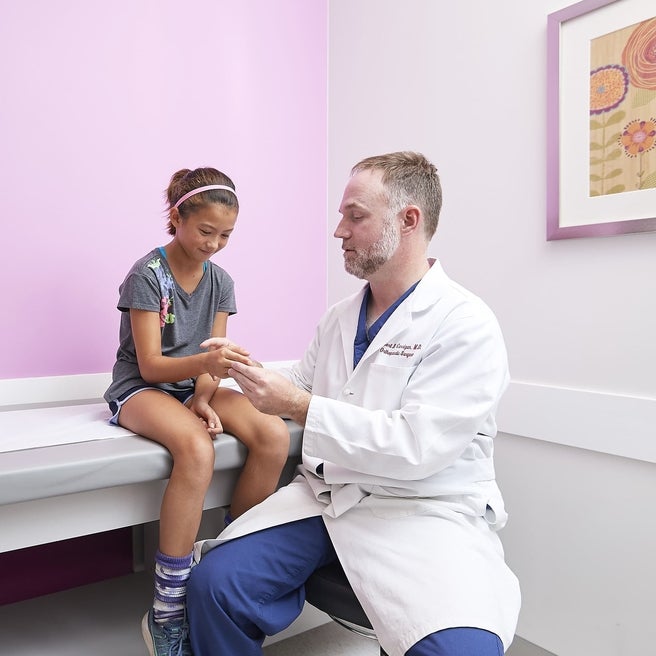What is clinodactyly?
Clinodactyly is the medical term for an abnormally bent or curved finger. The affected finger abnormally curves to the side and may overlap other fingers. While the condition is relatively rare among the general population (3 percent), it affects one in four children born with Down syndrome (trisomy 21).
Unless the curved finger is severe, clinodactyly may go unnoticed for years. The condition doesn’t cause pain and in most cases, does not affect hand function.
Treatment for clinodactyly varies depends on the severity of the condition, but can include ongoing monitoring and surgery.
Causes
Clinodactyly is a congenital condition, meaning it is present at birth even if it is not discovered until later. Clinodactyly can be inherited, or your child may be the first person in your family to have the condition. It can also be a symptom of an associated syndrome.
Clinodactyly is typically caused by the growth of an abnormally shaped bone in your child’s finger, which causes the finger to curve to the side. It may also be due to an irregular growth plate in one of the bones of your child’s finger.
Signs and symptoms
The primary symptom of clinodactyly is a finger that is abnormally curved in the middle. It may overlap with other fingers on the hand. In most cases, the condition does not cause pain, swelling or inflammation.
If your child’s condition includes a curve of more than 30 degrees, it may affect their hand function.
Testing and diagnosis
At Children's Hospital of Philadelphia (CHOP), diagnosing clinodactyly typically begins with a physical examination of your child’s fingers and hand.
In most cases, clinicians will recommend an X-ray to confirm the diagnosis. X-rays produce images of bones and help doctors identify the underlying structure of the hand. In the case of clinodactyly, a distinctive c-shaped bone can typically be seen in the middle bone of the affected finger.
In addition to a physical exam and X-rays, your child may also undergo:
- Range of motions tests to determine if the condition is affecting movement and dexterity
Accurate diagnosis helps us determine the best course of treatment for your child.
Treatment
Treatment for clinodactyly will depend on the severity of your child’s condition, as well as the age and development of your child.
Nonsurgical treatment
If your child’s finger is only slightly curved — and there is no problem using the fingers — clinicians will usually recommend ongoing observation to ensure the condition doesn’t worsen.
In most cases, splinting or stretching the finger is not recommended.
Surgical treatment
If your child’s clinodactyly is severe (more than 30-degree curvature) or significantly affecting her daily activities, surgery may be recommended. Surgery is most effective if performed while your child is still young and her bones are not fully matured.
At CHOP, board-certified orthopedic and plastic surgeons perform a variety of operations to repair bone deformities and improve function for children with hand conditions.
Surgery for clinodactyly typically involves a phalanx-opening wedge osteotomy procedure. During this multi-step procedure, doctors will:
- Remove a wedge-shaped portion of the curved bone in the affected finger
- Stabilize the finger
- Ensure the bones and soft tissues are lined up properly within the finger
- Ensure the corrected finger lines up with the other fingers on the hand
After surgery, your child’s finger will be immobilized with a cast or splint. Doctors may also recommend a sling for your child’s arm to further protect the hand and finger as it heals.
Follow-up care
Follow-up care for clinodactyly will depend on the treatment needed. If your child received nonsurgical treatment, they should be monitored regularly to ensure the condition does not begin to significantly affect his daily activities.
If your child had surgery, they will be examined at 2 weeks and 6 weeks post-operatively, then monitored regularly. Your child’s doctor will give you specific information about a recovery program for your child and how soon they can return to daily activities.
Outlook
The long-term outlook for children with clinodactyly is very good. Many children with the condition can avoid surgery. For children with more severe curvature of the finger, surgery can improve hand function and help children better manage their daily activities.
Resources to help
Hand and Arm Disorders Program Resources
We have compiled resources to help you find answers to your questions and feel confident with the care you are providing your child.
Reviewed by Robert B. Carrigan, MD
